Playback Range Functions
Overview of Playback Range controls
The Playback Range Track lets the user insert one or more blocks highlighting regions of the timeline for setting a specific range for:
- Auditioning (with optional repeat)
- Process creation (with one click)
- Exporting one or more tracks of audio
Using the Playback Range for auditioning helps the user:
- Find the start and/or stop of an audio event of interest
- Set areas for repeated or looped listening to:
- Compare inputs with processed outputs to check changes or quality
- Compare the effect of modifying process parameters while listening, to get the best results
 Playback ranges are particularly useful when the Rewind and Loop controls are activated (as shown in picture left).
Playback ranges are particularly useful when the Rewind and Loop controls are activated (as shown in picture left).
When used for Process Creation, once an APT or Doubler process control has been set up, a Playback Range can allow a new process to be created with as little as one keystroke.
Setting Screen Position of Playback Range Track
When Revoice Pro is first started, the Playback Range Track initially appears at the bottom of the Revoice Pro window with the text "Click and Drag to Insert a Playback Range".
However, the user can optionally set the screen position of this Track to the top of the Revoice Pro window in the Preferences control of Revoice Pro.
Mac OS: Select Revoice Pro in the Revoice Pro menu bar, select Preferences, and open the General tab to open the window shown below. The selection is under Window layout
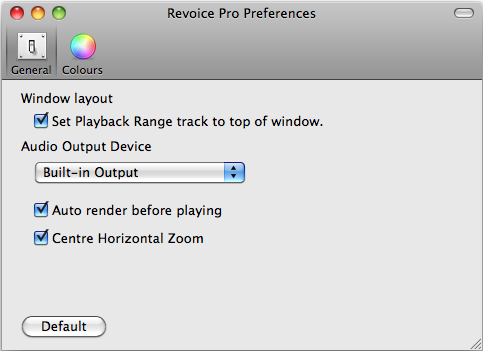
Windows OS: Select Edit in the Revoice Pro menu bar then click Preferences to open the window shown below.
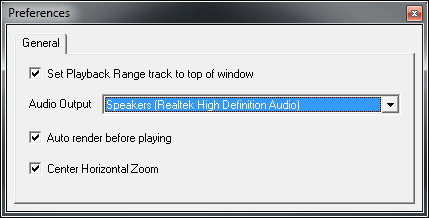
For both Mac and Windows, tick the box to select Set Playback Range Track to top of window.
In the image below, the Playback Range track is shown at the top of the Revoice Pro window.
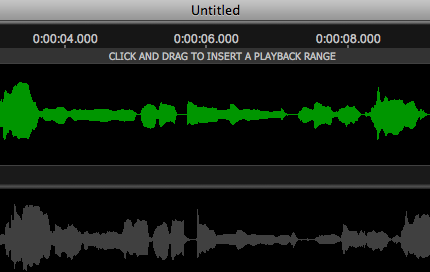
Back to Index
Inserting a Playback Range
- To set a Playback Range, click and hold down the Left Mouse button in the Playback Range Track and drag cursor to the right (or left) to create the Playback Range - shown in the picture below by the temporary highlighted area between vertical yellow end markers.
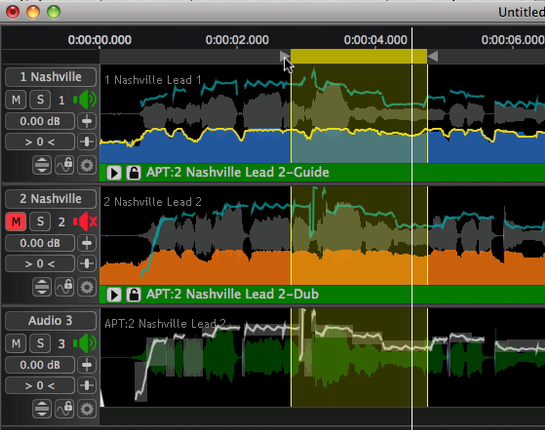
- When the mouse key is released – the block will be set in place as shown below.
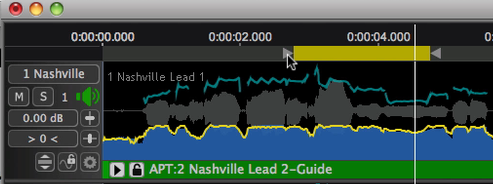
- The ends of the resulting Playback Range block can be trimmed by placing the cursor on the triangles at either end, hold down the Left Mouse button to get the extended yellow end markers as shown in the first image above. Drag the selected start or end of the Playback Range to the desired location(s).
- Using the mouse as described in (1) above, you can insert a new Playback Range block in an empty area of the Playback Range Track, that will replace the current one.
- A Playback Range can also be inserted by highlighting a group of notes or pitch blocks in Warp or APT output displays and pressing the Y key on the computer keyboard.
Back to Index
The Playback Range Menu
RIGHT CLICKing on a Playback Range will bring up the menu shown below.
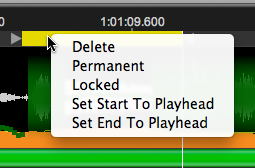
When entries in this menu are LEFT CLICKED the following additional useful functions will occur.
Delete:- Removes the selected Playback Range block.
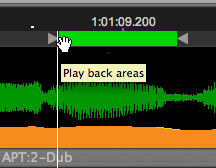 Permanent:- Makes a Playback Range remain visible (in dark green if unselected and light green if selected) even if other Playback Ranges are created. Permanent Playback Ranges can be edited.
Permanent:- Makes a Playback Range remain visible (in dark green if unselected and light green if selected) even if other Playback Ranges are created. Permanent Playback Ranges can be edited.
The entire Permanent Playback Range can be dragged by putting the cursor in the green block region between the end markers and the hand icon will appear as shown in image at the right. LEFT CLICK and drag right or left as required.
Locked:- Makes a Playback Range Permanent and not changeable (unless it is first unlocked or deleted). A Lock icon will appear in the Playback Range.
In the image below, we show a Permanent Playback Range (selected), a Locked Playback Range and a "normal" unselected Playback Range.

When multiple Playback Ranges are used, the Up and Down arrow keys can be used to step along from the starts to the ends of each of these sequentially.
The last two menu items above allow the user to set the Playback Start or End from the cursor position. This is particularly useful if a Playback Region extends beyond the screen edges.
Set Start to Playhead:- Will reset the start of the Playback Region to the position of the Playhead.
Set End to Playhead:- Will reset the end of the Playback Region to the position of the Playhead as shown below.



Back to Index
Create Processes using Playback Range
Setting a Playback Range to define the limits of an APT or Doubler process is one of the fastest and efficient means for breaking up the signal into processing sections. In this section we will show how to quickly create two processes with a minimum of keystrokes.
The basic idea is that the New Process window, shown below, (which can be toggled open and closed with the B key), detects when a Playback Range (shown at the top of the windo below) is created or adjusted.

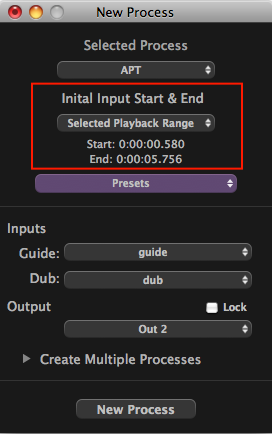 If it is, then Selected Playback Range is selected automatically in the New Process window and displayed under Initial Input Start & End, with the correct range set as shown in the picture left in the red box.
If it is, then Selected Playback Range is selected automatically in the New Process window and displayed under Initial Input Start & End, with the correct range set as shown in the picture left in the red box.
Once the process range is set, the user only needs to press the N key on the keyboard (or the New Process button in the New Process window) to create the new Process Control Blocks as shown below (APT:dub unprocessed).
Process created this way will use the process User Default Preset settings. Changing Settings are discussed further in the APT or Doubler chapters.
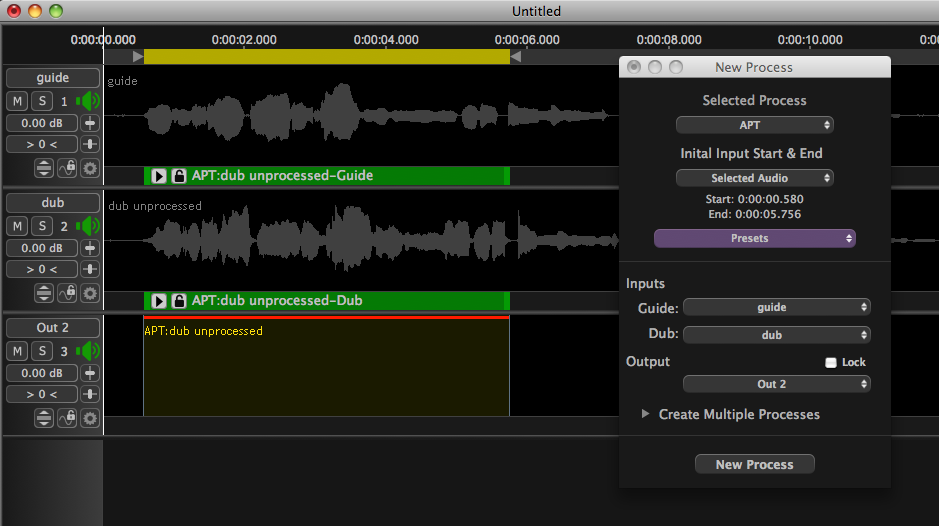
If the user believes the process settings are correct, then simply pressing the Space Bar will Render the process (as shown below) and start playback of the audio in the Playback Range just processed.
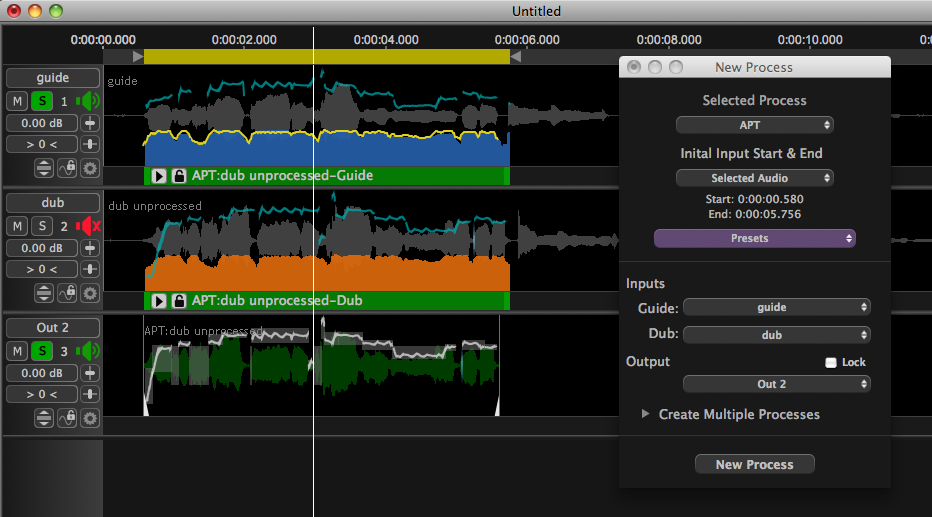
If that process sounds OK, to create another process quickly, a new Playback Range can be created by clicking and dragging in the Playback Range Track where it is wanted.
One special trick for creating a Playback Range that starts where the last one ended, is to drag the start triangle of the previous Playback Range across the end of that playback range and on to the right to where the new end will be wanted. Below, the red circle and arrow show the start and end of this drag movement and the result is shown below.
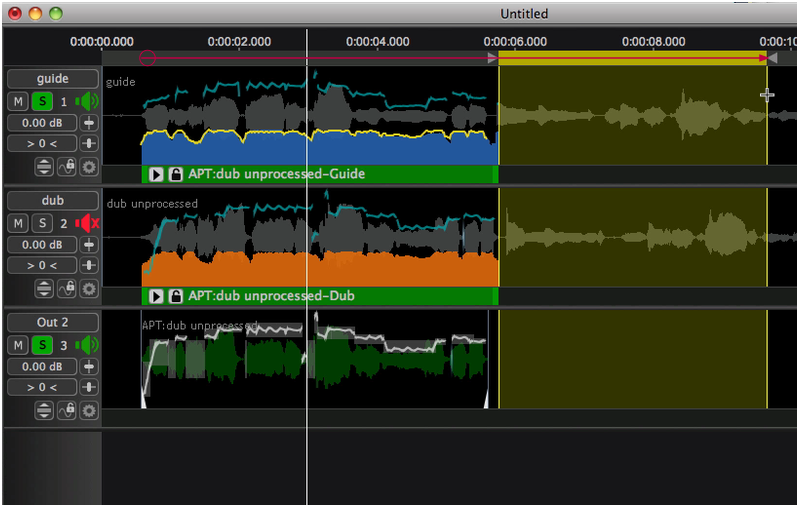
Pressing the N key while the New Process window is open will create the new process (APT:dub unprocessed(2)) as before and pressing the space bar will render the output and play the new output range as shown below.
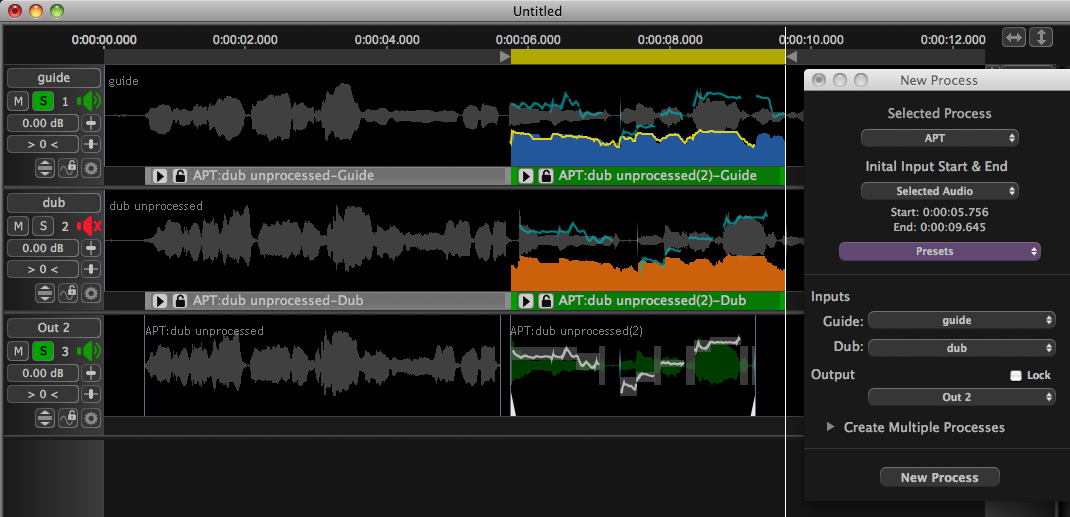
Use Process Range to set Playback Range
One way to quickly set a Playback Range is to set it to the same range as a Process Control Block. For example, a short Playback Range is shown below in yellow and an APT Guide Process Control block is shown in green.

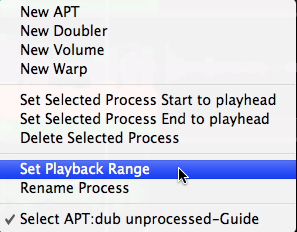 RIGHT CLICKing on the Process Control Block, and selecting "Set Playback Range" shown in blue in the menu shown right, will cause the Playback Range to be set to the same length as the Process Control Block. This is shown in the image below.
RIGHT CLICKing on the Process Control Block, and selecting "Set Playback Range" shown in blue in the menu shown right, will cause the Playback Range to be set to the same length as the Process Control Block. This is shown in the image below.

How to use Playback Regions during Playback
- Playback- When the space bar is pressed to start or stop playback, the playback (shown by the Playhead motion) will start at the start of the last-selected Playback Region block.
- If the Rewind switch is ON, then pressing the spacebar will toggle stop and then start playback from the Block start, unless the user manually resets the playhead before starting. Then, that new starting position will be used.
- If the Loop switch is on, when the Playhead reaches the end of the block, it will automatically jump to the start of the block.
- The start and end of the blocks can be moved while playing, and the new positions will be used immediately.
- The up arrow and down arrow keys on the keyboard will send the Playhead stepping to the start or end of successive Playback Region blocks or other "events" defined by the start and stop of any audio waveform sections loaded in the tracks.
- While playing back, the user can select tracks to hear or mute by pressing the various monitor enable, mute and solo switches. For more information, click here.

